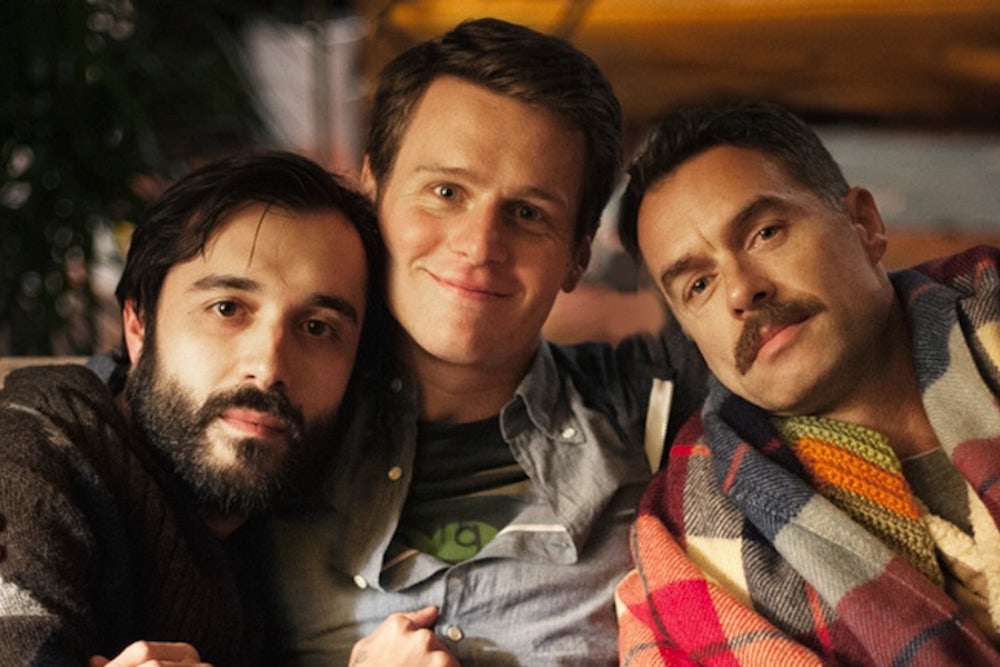“Looking,” the new HBO series from collaborators Michael Lannan and Andrew Haigh that premieres Sunday, has plenty of sex. There is sex in a park, spontaneous three-ways, quick hookups between daddies and twinks on Grindr. But the show’s low-fi naturalism downplays any shock factor, insisting on its own ordinariness. And so it is surprising that the series has drawn so many comparisons to that other show about urban millennials, “Girls.” Aside from focusing on a group of young people fumbling through life and love, these shows actually have little in common. Lena Dunham and her posse thrive on cringe-worthy, larger-than-life moments, cooking up situations that approach reality only by being so pointedly exaggerated. But the charms of “Looking” are more subtle, rooted more in the nuances of the character’s friendships, the gauzy, improvisational quality of its script, and the straight-faced realism of its take on modern gay life in San Francisco. In fact, “Looking” is the first truly post-DOMA show, luxuriating in the mundaneness of gay men’s lives without needing to dress them up in mainstream television’s usual tropes of same-sex marriage, gay parenting and “acceptance.”
It’s a refreshing development: When these issues do come up on “Looking,” they are peripheral to the lives of the three main leads. Patrick, Agustin and Dom (Jonathan Groff, Frankie J. Alvarez and Murray Bartlett, respectively) range in age from 29 to 39, and are each seeking romantic and professional fulfillment in Jerry Brown’s Second Term California. Patrick is a geeky video-game designer torn between pleasing his new boss (Russell Tovey) and the sexy Mexican hairstylist who hits on him on the BART (Raul Castillo). Agustin is an artist’s assistant, ready to try out domesticity in Oakland but still ambivalent about giving up on city life. Dom, the oldest of the three, waits tables at the same restaurant where he’s been working for over eight years, and dreams of opening up his own Peri Peri chicken joint. In every sense, the men on “Looking” come across as relatable and familiar, fully human in their desires and shortcomings: Patrick is overeager and awkward on dates. Dom is jealous of an old flame’s success. When Agustin gets pissy with his boss, she fires him.
All this brings to mind the seminal show about gay male friendships, Showtime’s “Queer as Folk.” Side by side comparisons of these two series could provide no better testimony to just how far gay rights have progressed in the last decade. Homophobia wasn’t just an issue in “Queer as Folk”—it was the issue. On “Looking,” it hasn’t yet come up in the four episodes I’ve watched, much as it likely doesn’t come up often on the streets of San Francisco. Identity politics, internalized shame, and grassroots activism have been replaced by the more quotidian concerns of Zumba, NSFW internet browsing, and what to wear to the Folsom Street Fair.
Yet there is something subversive going on here. For years the argument went that gay men and lesbians were just like everyone else. They wanted the same things—love, commitment, family—that their heterosexual peers wanted. “Looking” suggests that, while this may be true, the ways in which gay men define love, commitment, and family are not necessarily constrained to the focus-group-approved talking points that progressive activists have been hawking for so many years now.
Certainly Agustin—who moves in with his boyfriend but refuses to entertain the idea of monogamy (“All men cheat eventually,” he says), and flirts with the idea of becoming a sex worker after meeting one in a coffee shop—would not be the poster child held up by the folks at HRC as to why LGBT people deserve equal rights. But as we move beyond issues of rights, shouldn’t the next generation of television shows allow for a broader spectrum of gay characters, not just your Kirks and Cams and Mitchells? A similar progression occurred with African American characters as TV transitioned from the '70s into the '80s, when shows such as “Good Times” and “What’s Happening” made way for “The Cosby Show” and “A Different World.”
With its numerous references to Instagram, OK Cupid, Facebook, and Grindr, “Looking” aims to be very much of the moment. But there is a danger in embracing reality so fully—it leaves little room for the exploration of more universal truths via the possible rather than the actual. “Girls” is such a watercooler show because it dares to thrust its cast into dark, thorny places, to amplify the self-absorbed narcissism of its central characters in order to arrive at some hard-earned nuggets about what it means to be an urban twenty-something female today. “Looking” is satisfied with giving you a peek into the lives of fairly ordinary gay men—without satire or larger commentary, but also without the sex-expunging, kumbaya-we’re-all-alike platitudes of shows like “Glee” and “Modern Family.”
And yet, I still found myself drawn in, wishing that Patrick would finally connect with Richie, hoping that Agustin and Frank could find a way to make their relationship work, rooting for Dom to convince Lynn (Scott Bakula) to invest in his new restaurant. The situations may seem familiar, but they are funny and comforting. One day, a twenty something gay man will come along and skewer his peers much as Lena Dunham does hers—it’s not as if the gay community in San Francisco (or elsewhere) isn’t ripe for satire. But perhaps America isn’t ready for its gay “Girls” just yet.
Eric Sasson writes Ctrl-Alt, a column on alternative culture for the Wall Street Journal. He is the author of Margins of Tolerance. You can follow him on Twitter @idazlei or visit his website here.
